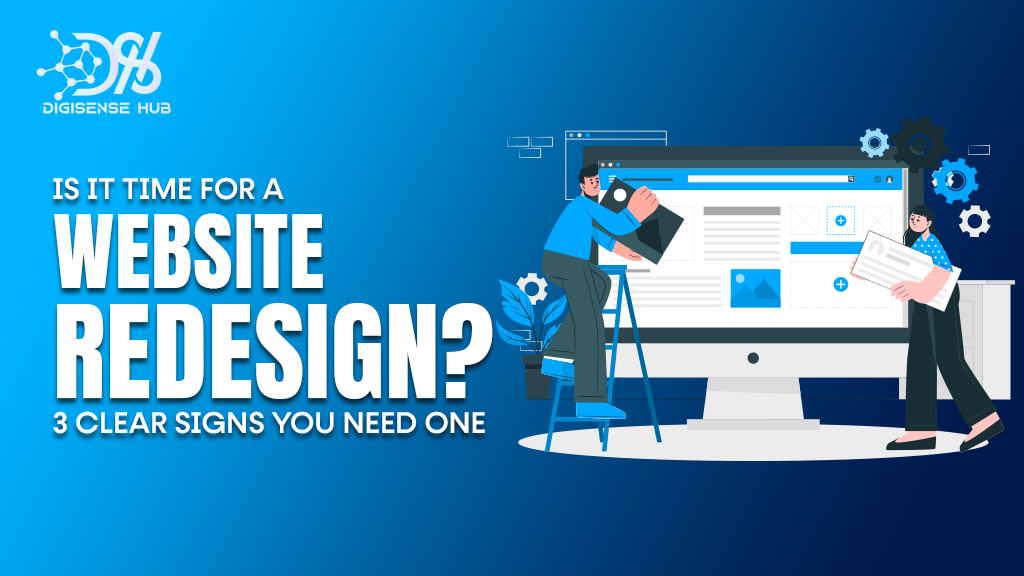Overview
Your website redesign is one of the most critical components of your online presence. It acts as the digital face of your brand, and its design, functionality, and usability directly impact how visitors perceive your business. However, websites can become outdated over time, both in terms of design trends and technological advancements. If your site isn’t performing as expected or isn’t aligned with your current business goals, it might be time for a redesign.
1. Outdated Design and Functionality
The digital landscape evolves rapidly, and what was considered cutting-edge a few years ago can feel stale today. Your website’s design and functionality must keep up with modern expectations to maintain credibility and engage visitors effectively.
How to Spot an Outdated Design
- Visual Style: If your website still features old-fashioned layouts, outdated typography, or excessive use of stock imagery, it can make your business appear out of touch.
- Mobile Responsiveness: With over half of all web traffic coming from mobile devices, a responsive design is no longer optional. If your site doesn’t adjust seamlessly to different screen sizes, it’s time for a redesign.
- Technology: Older websites may rely on outdated technologies like Flash, which are no longer supported by most browsers. Similarly, sites built with antiquated coding practices might experience frequent bugs and compatibility issues.
Why It Matters
- Beauty is skin deep; the first things that appeal to the eyes are normally impressive. Twenty-five hundred milliseconds are said to be enough for users to develop a first opinion about a website. A poorly chosen design seems to show that the business is old-fashioned or that it is simply unreliable. Also, if the functionality is old, it can enrage the visitors or, at the very least, barrage them off.
- Solution: A redesign is helpful in giving your website a new, updated look that shows your brand as professional and progressive. Acquire easy-to-navigate, up-to-date, and modernize your app’s style and design to leave an incredible first impression.
2. Poor User Experience (UX)
UX includes anything from the ease of use of your website to how quickly the website loads. People do not like complicated websites or those with a slow response time and end up leaving your site instead of making a purchase.
Common UX Issues
- Slow Loading Times: The main finding that I discovered is that users are patient but demand that a webpage comes up in three seconds or less. If things are any slower, it results in a huge traffic decrease.
- Confusing Navigation: If the audience cannot search and find what they wanted on that particular website, they are most likely to exit. This issue can be caused by many things, such as having poor navigation structures, confusing menus, or not having menus that offer searching capability.
- Accessibility Challenges: Today’s web has to be accessible by everyone, including those with disabilities. Don’t, for example, offer your website without keyboard navigation or not have it compatible with screen readers; then you are essentially ignoring a large portion of your users.
Why It Matters
One ill-conceived approach regarding the practical use of a product or its applicability in each set up not only distracts potential clients but also costs you your search engine rank. Google uses speed, maps, and seamlessness, as well as engaging site experiences, as important factors for ranking.
Solution: If there is an emphasis placed on redesigning your website to create a better UX, users spend more time on your site, get better conversion rates, and increase your all-important SEO. Factors such as easy-to-use navigation, short page loading times, and compliance with web standards help design a site that will please every single visitor.
3. Your Business Goals Have Evolved
Only this way will your website be dynamic and accurate to the changes that may be occurring in your business from time to time. If your site is not in compliance with its purpose or the current goals and products or services that you are venturing into, then it is not an effective site.
7 Bad Signals Writing Your Website
- Inaccurate Information: If your website lacks updated information that demonstrates your latest products, services, and achievements, then it needs an update.
- Limited Functionality: Companies have changed over time and so have their websites, and hence businesses outgrow their websites. For instance, there may be a need to implement e-commerce functionality, include CRM integration, or implement the capability for bookings and scheduling.
- Inability to Scale: how difficult it is for your website to resource traffic or how it fails to support new tools and technologies, it is your business loss.
Why It Matters
Your website is an active resource that has to be instrumental in achieving your company goals. An out-of-date or out-of-sync site can mislead the customer and tear apart a marketing campaign, and most of all, stifle growth on the internet.
Solution: Redesigning presents an opportunity to bring the website back into focus with the objective of the business. This could involve modifying the content of the information provided, enriching a website with new elements, or enhancing the site’s capability to handle increased business.
Advantages of Having a Website Redesign
If you recognize any of these signs, a website redesign can offer numerous advantages:
- Enhanced Branding: Fresh design will make sure your site looks as you want it to look for your brand and represents your brand values.
- Improved Performance: Enhanced site speed, user experience, and existing features make the site run more smoothly.
- Higher Engagement: An easily navigable layout means that potential visitors will stick around longer with and engage more with your website’s content.
- Better SEO Rankings: Google prefers sites that are fast, mobile, and provide users with what they expect, or even more.
- Increased Conversions: A website can bring better conversion rates; in this case, the location and layout of the website elements will help the buyer move from one stage to another of his journey easily.
How to Approach Website Redesign
Redesigning a website is a significant investment, so it’s essential to approach it strategically. Here’s a step-by-step guide to ensure a successful redesign:
- Evaluate Your Current Website: Conduct an audit to identify areas for improvement, such as outdated designs, slow pages, or poor navigation.
- Define Your Goals: Determine what you want to achieve with the redesign, such as improved UX, better SEO performance, or new features.
- Choose the Right Team: Partner with a professional web design agency or hire experienced developers who understand your business needs.
- Focus on the User: Prioritize the needs and preferences of your target audience in every design decision.
- Test and Launch: Before going live, thoroughly test your website redesign to ensure it’s free of errors and performs well across all devices.
Why Businesses in India and Beyond Trust DigiSenseHub
India’s vibrant digital economy demands innovation, and DigiSenseHub rises to the challenge with:
- Competitive pricing without compromising quality.
- Access to a skilled team of developers and designers.
- Commitment to deadlines and project milestones.
If you’re looking for a website development company in India that combines creativity, technical expertise, and a customer-first approach, DigiSenseHub is the partner you need.
Reach out today to start building a website that drives success for your business!
Final Thoughts
Your website is more than just a digital storefront—it’s a reflection of your brand and a key driver of business success. If your site is outdated, offers poor user experience, or no longer aligns with your goals, it’s time for a website redesign.
By addressing these issues and embracing modern design trends, you can create a website that not only attracts visitors but also converts them into loyal customers. A well-executed redesign is an investment in your business’s future, ensuring you remain competitive in an ever-changing digital landscape.
Take the first step today and evaluate your website. If it’s time for a change, start planning your redesign to unlock your site’s full potential.


